On-Orbit Modulation Transfer Function Estimation Based on the Refined Image Kernel
Abstract
:1. Introduction
2. Fundamentals of Measurement
2.1. Modeling of Modulation Transfer Function
2.2. Kernel Estimation Method
2.2.1. Estimation of the Initial Kernel
2.2.2. Kernel Elaboration Based on the ISD Algorithm
3. Influences on the Accuracy of Kernel Estimation
4. Description of the Process
- In the target image, select several sub-images with rich texture details, every 500 × 500 pixels in size;
- For each sub-image, evaluate the kernel using the principles and computational calculation process given in Section 2.2 of this study;
- Calculate the central pixel energy concentration of each kernel according to Equation (15). If a discrete value is too high or too low, the related kernel is deemed unreliable and rejected. After refining, the refined image kernels are obtained;
- The refined image kernel is interpolated to build the PSF, and FFT is performed to obtain the 2-D MTF. The longitudinal and transverse directions are selected to obtain the MTF curves in both directions, and the MTFs at the Nyquist frequency are picked;
- The final MTF is determined by averaging the MTFs of the two directions from step 4.
5. Ground Experimental Results and Analysis
5.1. Validation Experiment of the MTF Measurement Method
5.2. The Effect of Image MTF Levels on Measurement Accuracy
5.3. The Influence of Image SNR on MTF Measurement Results
6. Application of On-Orbit Satellite MTF Assessment
7. Conclusions
Author Contributions
Funding
Institutional Review Board Statement
Informed Consent Statement
Data Availability Statement
Conflicts of Interest
References
- Dusseux, P.; Hubert-Moy, L.; Corpetti, T.; Vertès, F. Evaluation of SPOT imagery for the estimation of grassland biomass. Int. J. Appl. Earth Obs. Geoinf. 2015, 38, 72–77. [Google Scholar] [CrossRef]
- Kim, D.; Park, M.S.; Park, Y.J.; Kim, W. Geostationary Ocean Color Imager (GOCI) Marine Fog Detection in Combination with Himawari-8 Based on the Decision Tree. Remote Sens. 2020, 12, 149. [Google Scholar] [CrossRef]
- Yun, R.; Zhu, C.; Xiao, S. Deformable Faster R-CNN with Aggregating Multi-Layer Features for Partially Occluded Object Detection in Optical Remote Sensing Images. Remote Sens. 2018, 10, 1470. [Google Scholar] [CrossRef]
- Chathura, W.; Simon, J.; Karin, R.; Luke, W. Development of a Multi-Spatial Resolution Approach to the Surveillance of Active Fire Lines Using Himawari-8. Remote Sens. 2016, 8, 932. [Google Scholar] [CrossRef]
- Kenichiro; Masaoka. Practical edge-based modulation transfer function measurement. Opt. Express 2019, 27, 1345–1352. [Google Scholar] [CrossRef]
- Fang, Y.C.; Tzeng, Y.F.; Wu, K.Y.; Tsay, H.L.; Lin, P.M. Measurement and analysis of modulation transfer function of digital image sensors. Microsyst. Technol. 2022, 28, 137–142. [Google Scholar] [CrossRef]
- Masaoka, K. Edge-based modulation transfer function measurement method using a variable oversampling ratio. Opt. Express 2021, 29, 37628–37638. [Google Scholar] [CrossRef] [PubMed]
- Cui, L.y.; Xue, B.d.; Cao, X.g.; Dong, J.k.; Wang, J.n. Generalized atmospheric turbulence MTF for wave propagating through non-Kolmogorov turbulence. Opt. Express 2010, 18, 21269–21283. [Google Scholar] [CrossRef] [PubMed]
- Oh, E.; Choi, J.K. GOCI image enhancement using an MTF compensation technique for coastal water applications. Opt. Express 2014, 22, 26908–26918. [Google Scholar] [CrossRef] [PubMed]
- Vettenburg, T.; Bustin, N.; Harvey, A.R. Fidelity optimization for aberration-tolerant hybrid imaging systems. Opt. Express 2010, 18, 9220–9228. [Google Scholar] [CrossRef] [PubMed]
- Klapp, I.; Mendlovic, D. Improvement of matrix condition of Hybrid, space variant optics by the means of Parallel Optics design. Opt. Express 2009, 17, 11673–11689. [Google Scholar] [CrossRef] [PubMed]
- Viallefont-Robinet, F.; Helder, D.; Fraisse, R.; Newbury, A.; Bergh, F.v.d.; Lee, D.H.; Saunier, S. Comparison of MTF measurements using edge method: Towards reference data set. Opt. Express 2018, 26, 33625–33648. [Google Scholar] [CrossRef] [PubMed]
- Hwang, H.; Choi, Y.W.; Kwak, S.; Kim, M.; Park, W. MTF assessment of high resolution satellite images using ISO 12233 slanteded-edge method. In Proceedings of the Image and Signal Processing for Remote Sensing XIV, Cardiff, UK, 15–18 September 2008; SPIE: Bellingham, WA, USA, 2008; Volume 7109, pp. 34–42. [Google Scholar] [CrossRef]
- Xu, M.; Cong, M.; Li, H. Research of on-orbit MTF measurement for the satellite sensors. In Proceedings of the Remote Sensing of the Environment: 18th National Symposium on Remote Sensing of China, Zhangjiajie, China, 20–23 October 2012; SPIE: Bellingham, WA, USA, 2012; Volume 9158, pp. 45–52. [Google Scholar] [CrossRef]
- Horiuchi, S.; Yoshida, S.; Yamamoto, M. Simulation of modulation transfer function using a rendering method. Opt. Express 2013, 21, 7373–7383. [Google Scholar] [CrossRef] [PubMed]
- Cheng, Y.; Yi, H.; Liu, X. Lunar-edge based on-orbit modulation transfer function (MTF) measurement. In Proceedings of the AOPC 2017: Space Optics and Earth Imaging and Space Navigation, Beijing, China, 4–6 June 2017; SPIE: Bellingham, WA, USA, 2017; Volume 10463, pp. 432–439. [Google Scholar] [CrossRef]
- Masaoka, K.; Yamashita, T.; Nishida, Y.; Nishida, Y.; Sugawara, M. Modified slanteded-edge method and multidirectional modulation transfer function estimation. Opt. Express 2014, 22, 6040–6046. [Google Scholar] [CrossRef] [PubMed]
- Choi, T. IKONOS satellite on orbit modulation transfer function (MTF) measurement using edge and pulse method. Ph.D. Thesis, Electrical Engineering Department, South Dakota State University, Brookings, SD, USA, 2002. [Google Scholar]
- Kohm, K. Modulation transfer function measurement method and results for the Orbview-3 high resolution imaging satellite. In Proceedings of the ISPRS, Istanbul, Turkey, 12–23 July 2004; Volume 35, pp. 12–23. [Google Scholar]
- Storey, J.C. Landsat 7 on-orbit modulation transfer function estimation. In Sensors, Systems, and Next-Generation Satellites V; SPIE: Bellingham, WA, USA, 2001; Volume 4540, pp. 50–61. [Google Scholar] [CrossRef]
- Viallefont-Robinet, F.; Cansot, E. SPOT5 MTF measurement using biresolution images. In Proceedings of the Sensors, Systems, and Next-Generation Satellites VIII, Ottawa, ON, Canada, 13–16 September 2004; SPIE: Bellingham, WA, USA, 2004; Volume 5570, pp. 245–255. [Google Scholar] [CrossRef]
- Han, L.; Gao, K.; Dou, Z.; Wang, H.; Fu, X. On-orbit MTF estimation for GF-4 satellite using spatial multisampling on a new target. IEEE Geosci. Remote Sens. Lett. 2019, 17, 17–21. [Google Scholar] [CrossRef]
- Nelson, N.R.; Barry, P.S. Measurement of Hyperion MTF from on-orbit scenes. In Proceedings of the IEEE 2001 International Geoscience and Remote Sensing Symposium (Cat. No. 01CH37217), Sydney, Australia, 9–13 July 2001; Volume 7, pp. 2967–2969. [Google Scholar] [CrossRef]
- Pan, L.; Hartley, R.; Liu, M.; Dai, Y. Phase-only image based kernel estimation for single image blind deblurring. In Proceedings of the IEEE on CVPR., Long Beach, CA, USA, 20 June 2019; IEEE: Piscataway, NJ, USA, 2019; pp. 6034–6043. [Google Scholar] [CrossRef]
- Pan, J.S.; Hu, Z.; Su, Z.X.; Yang, M.H. L0-regularized intensity and gradient prior for deblurring text images and beyond. IEEE Trans. Pattern Anal. Mach. Intell. 2016, 39, 342–355. [Google Scholar] [CrossRef] [PubMed]
- Xu, L.; Jia, J.Y. Two-phase kernel estimation for robust motion deblurring. In Proceedings of the Computer Vision—ECCV 2010, Crete, Greece, 5–11 September 2010; Springer: Berlin/Heidelberg, Germany, 2010; pp. 157–170. [Google Scholar] [CrossRef]
- Neel, J.; Szeliski, R.; Kriegman, D.J. PSF estimation using sharp edge prediction. In Proceedings of the IEEE Conference on CVPR., Anchorage, AK, USA, 23–28 June 2008; IEEE: Piscataway, NJ, USA, 2008; pp. 1–8. [Google Scholar] [CrossRef]
- Wang, Y.; Yin, W. Compressed Sensing via Iterative Support Detection. SIAM J. Imaging Sci. 2009, 4359, 462–491. [Google Scholar] [CrossRef]
- Viallefont-Robinet, F. Edge method for on-orbit defocus assessment. Opt. Express 2010, 18, 20845–20851. [Google Scholar] [CrossRef] [PubMed]
- Zehtabian, A.; Nazari, A.; Ghassemian, H.; Gribaudo, M. Adaptive restoration of multispectral datasets used for SVM classification. Eur. J. Remote Sens. 2015, 48, 183–200. [Google Scholar] [CrossRef]
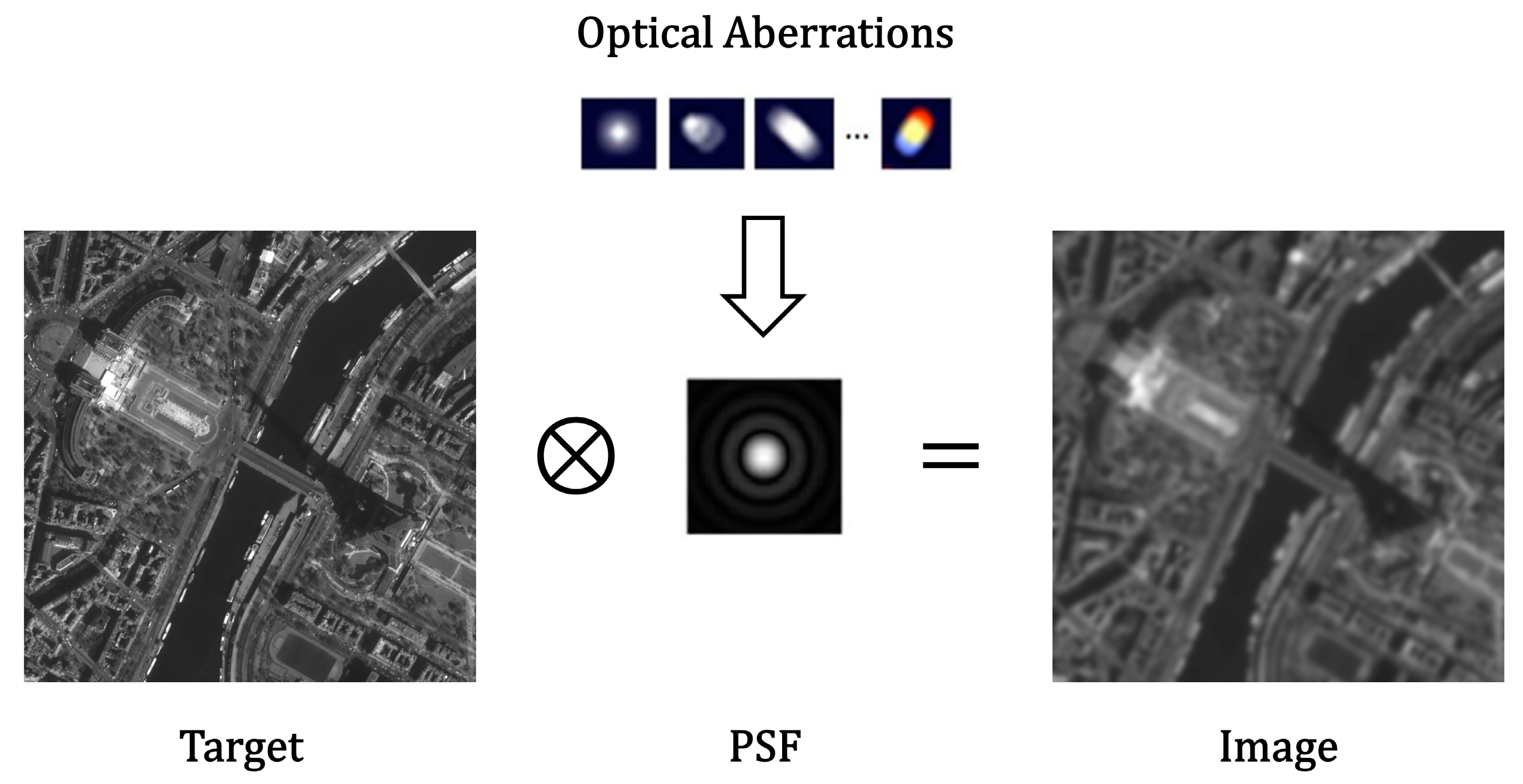
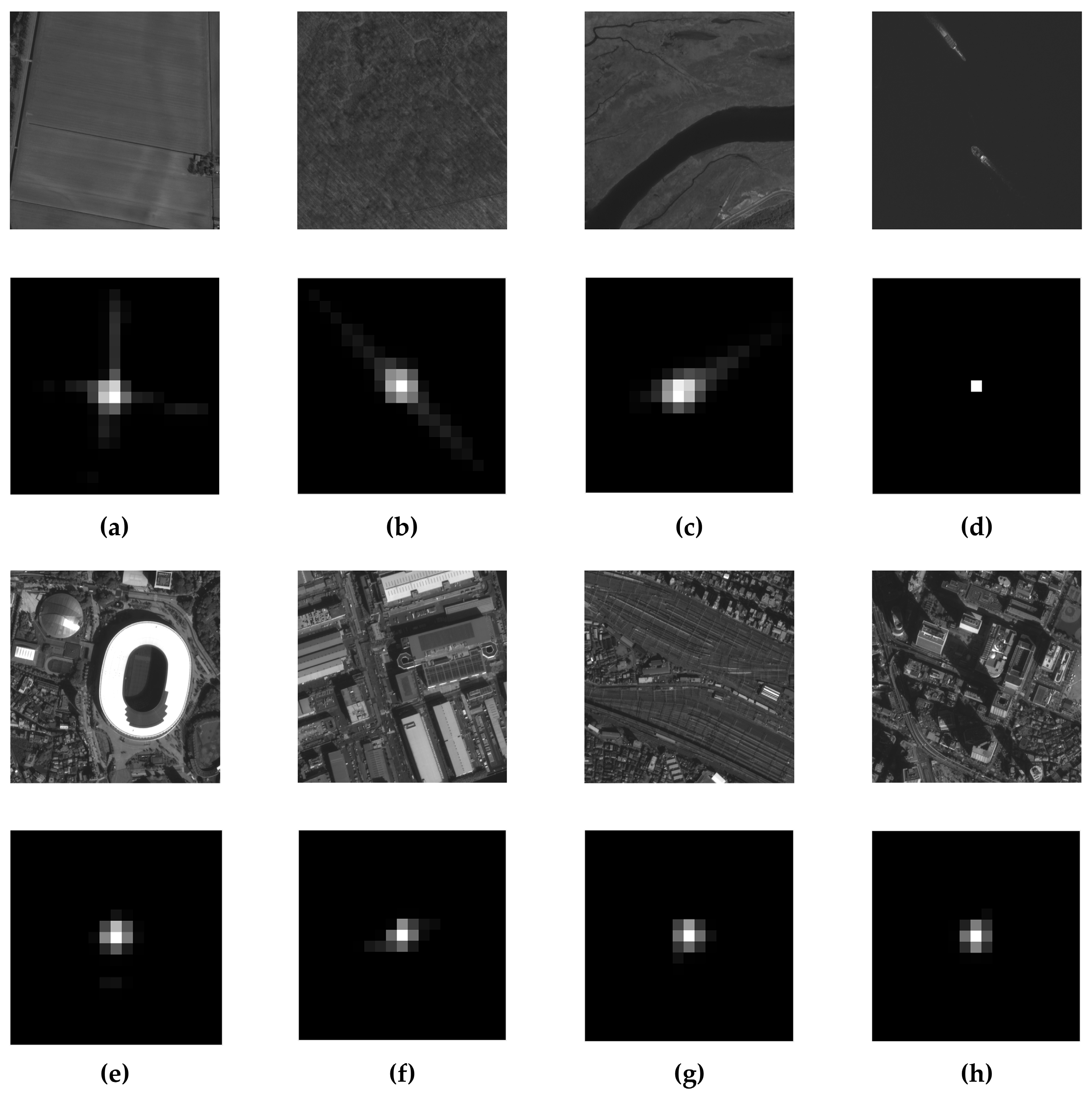
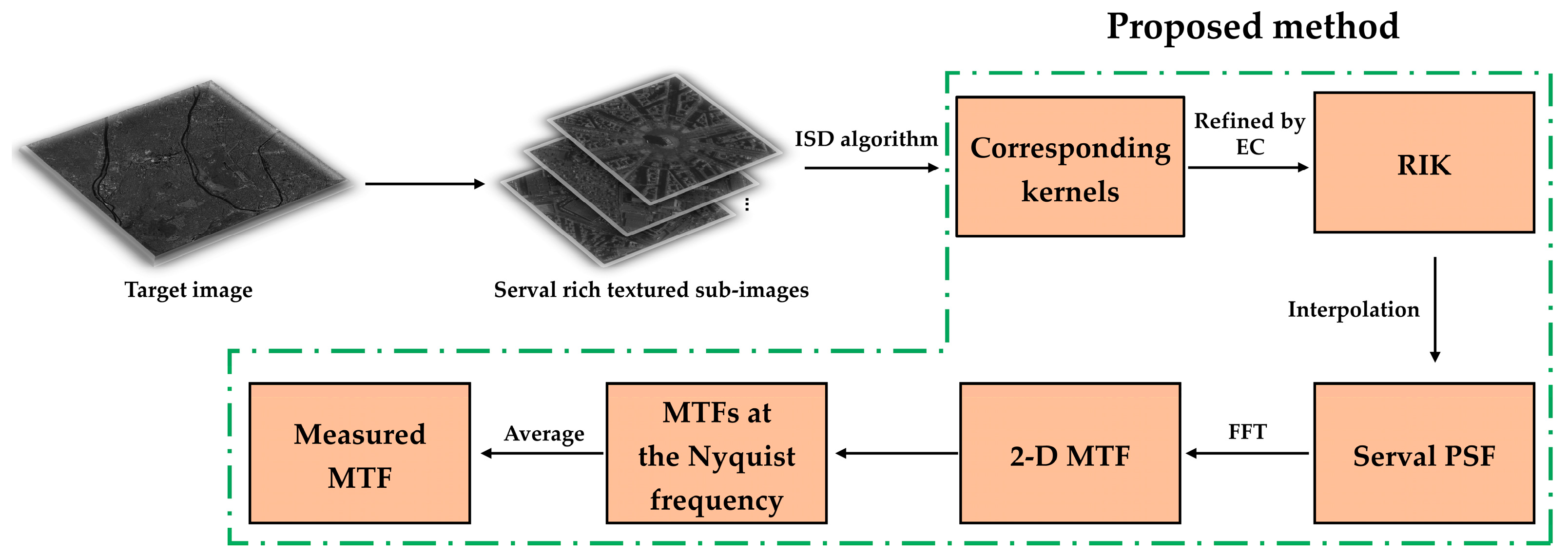


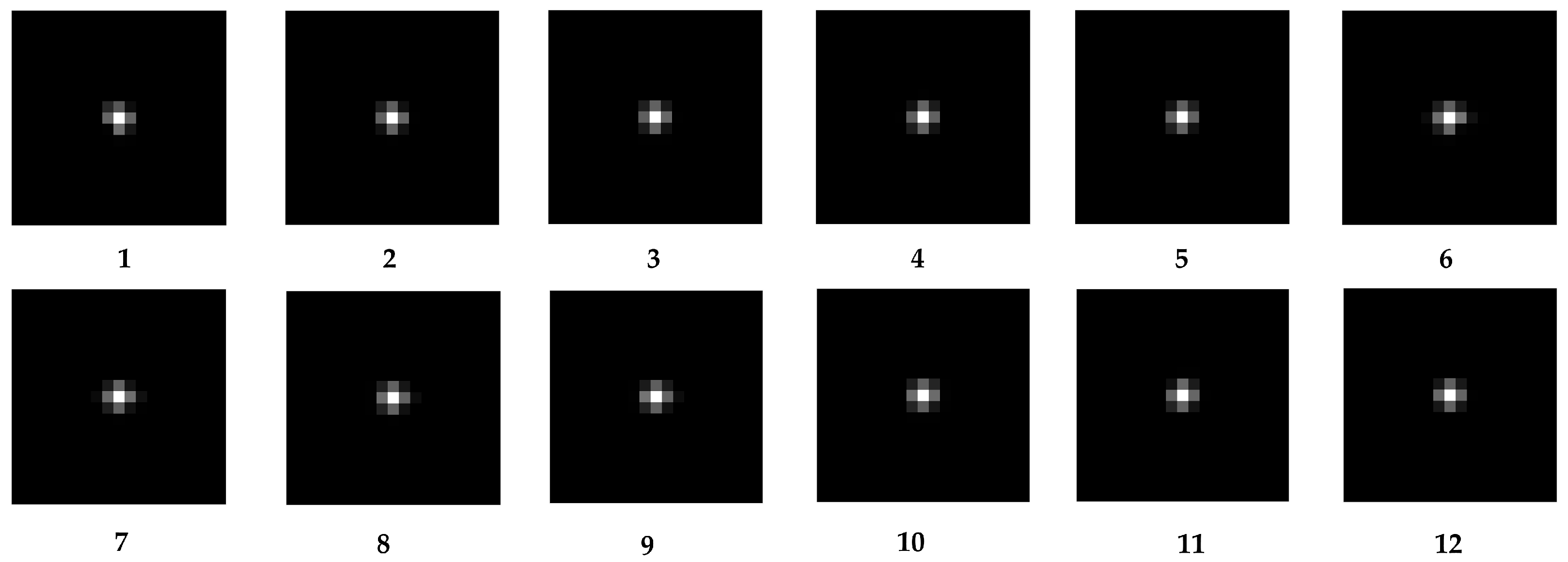


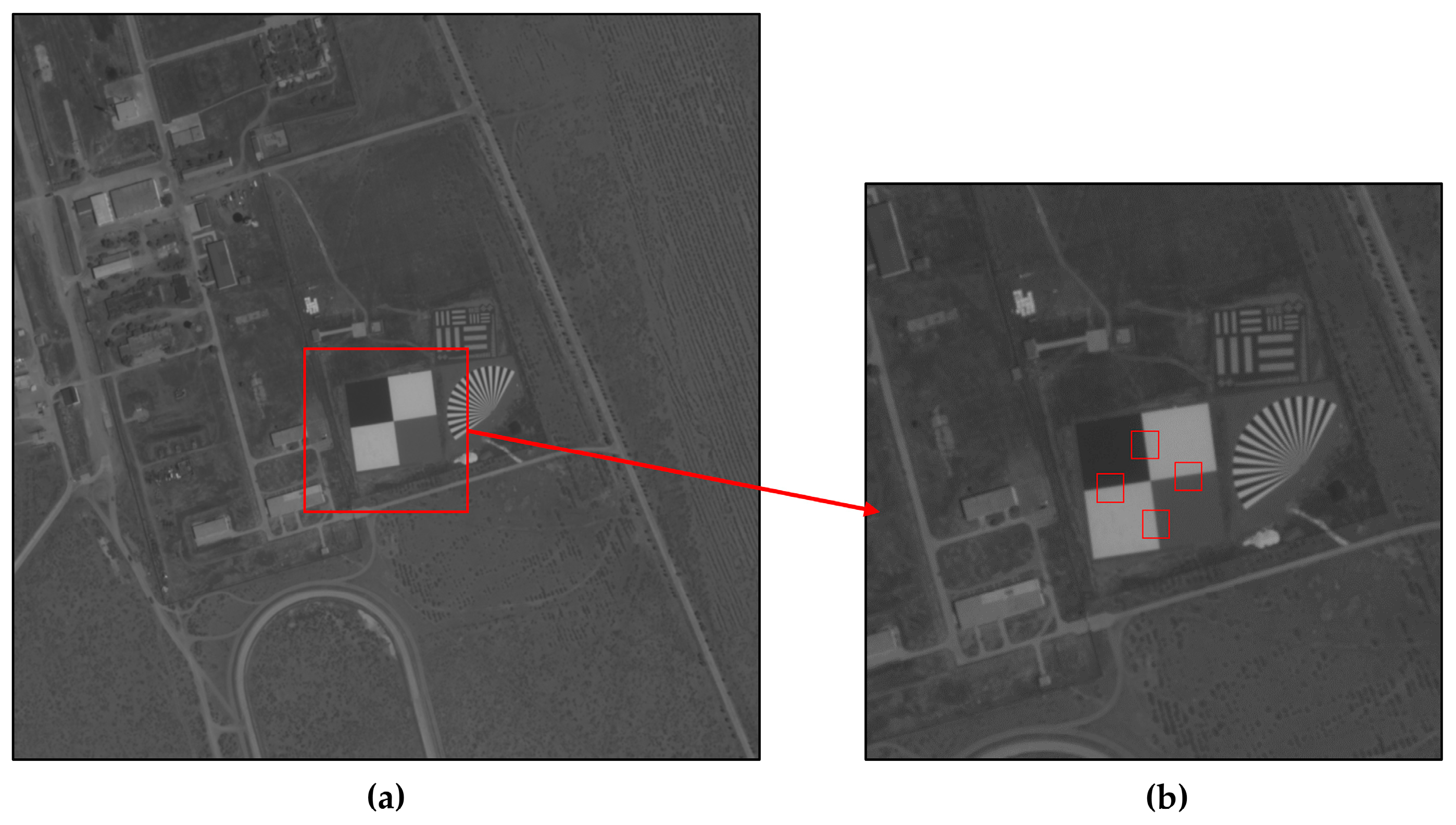
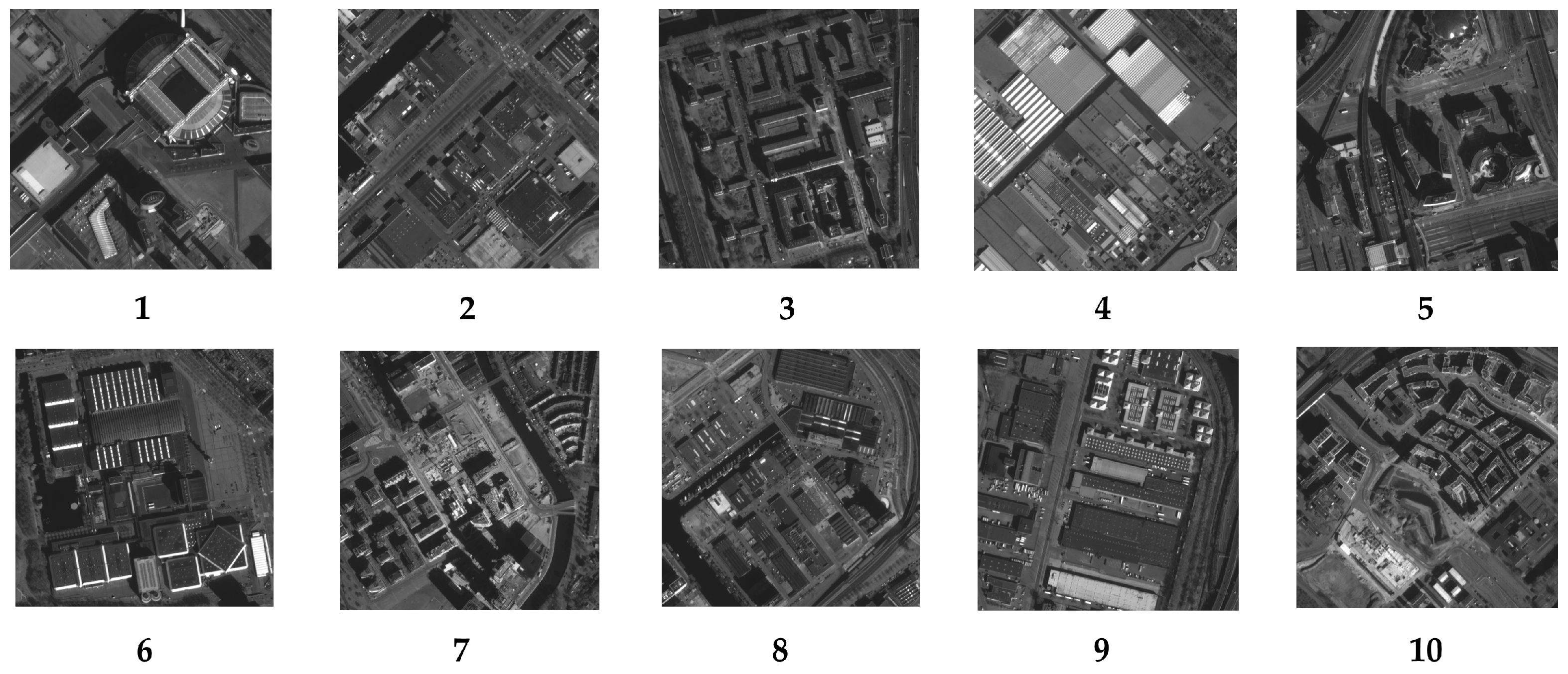
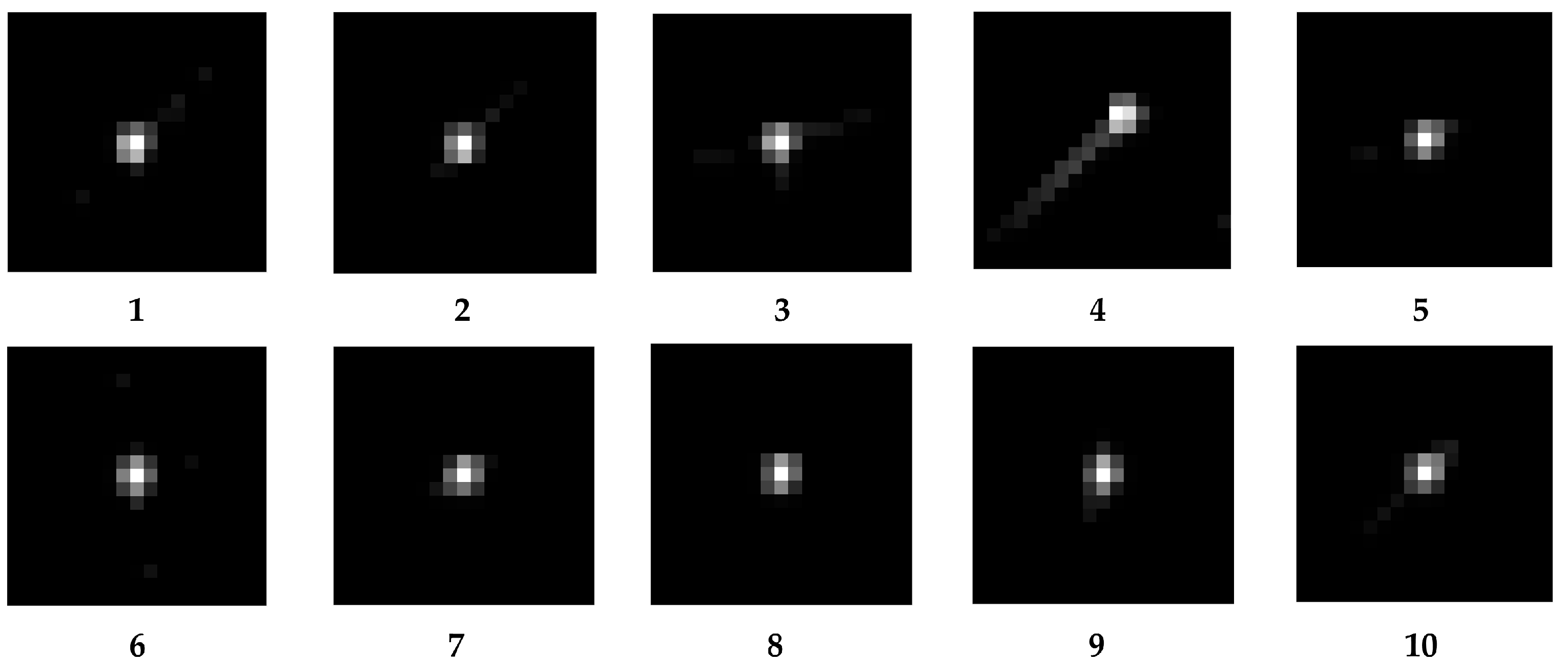
| Position | Value | Average | |
|---|---|---|---|
| MTFy | 2 | 0.275 | 0.2930 |
| 3 | 0.311 | ||
| MTFx | 1 | 0.293 | 0.2945 |
| 4 | 0.296 |
| No. | 1 | 2 | 3 | 4 | 5 | 6 |
| EC | 0.6017 | 0.6146 | 0.6040 | 0.6091 | 0.6071 | 0.5663 |
| No. | 7 | 8 | 9 | 10 | 11 | 12 |
| EC | 0.5820 | 0.5923 | 0.5903 | 0.5813 | 0.5903 | 0.6018 |
| No. | MTFy | MTFx |
|---|---|---|
| 1 | 0.30654 | 0.30689 |
| 2 | 0.29654 | 0.30514 |
| 3 | 0.28076 | 0.27833 |
| 4 | 0.29357 | 0.28511 |
| 5 | 0.28185 | 0.28691 |
| 6 | 0.23811 | 0.32868 |
| 7 | 0.24301 | 0.32773 |
| 8 | 0.25939 | 0.30106 |
| 9 | 0.24752 | 0.31009 |
| 10 | 0.23567 | 0.27820 |
| 11 | 0.28195 | 0.28091 |
| 12 | 0.27849 | 0.30007 |
| Standard Deviation | 2.45% | 1.77% |
| ISO12233 Edge | Our Method | Error | |
|---|---|---|---|
| MTFy | 0.2930 | 0.2703 | 6.83% |
| MTFx | 0.2945 | 0.2991 | 1.56% |
| Plan | MTFy | MTFx | ||
|---|---|---|---|---|
| MTFy-1 | MTFy-2 | MTFx-1 | MTFx-2 | |
| 57,648 | 0.240 | 0.234 | 0.134 | 0.168 |
| 57,676 | 0.216 | 0.243 | 0.143 | 0.147 |
| 57,784 | 0.244 | 0.253 | 0.132 | 0.153 |
| Average | 0.2383 | 0.1462 | ||
| No. | 1 | 2 | 3 | 4 | 5 | No. |
| EC | 0.3993 | 0.4480 | 0.4226 | 0.2814 | 0.3993 | EC |
| No. | 6 | 7 | 8 | 9 | 10 | No. |
| EC | 0.4491 | 0.4644 | 0.4721 | 0.4721 | 0.4634 | EC |
| No. | MTFy | MTFx |
|---|---|---|
| 1 | 0.26577 | 0.15738 |
| 2 | 0.22907 | 0.13844 |
| 3 | 0.21845 | 0.16020 |
| 5 | 0.19790 | 0.14565 |
| 6 | 0.28322 | 0.14446 |
| 7 | 0.20729 | 0.15260 |
| 8 | 0.26953 | 0.13841 |
| 9 | 0.28901 | 0.14984 |
| 10 | 0.15477 | 0.12696 |
| Standard Deviation | 4.51% | 1.04% |
| ISO12233 Edge | Our Method | Error | |
|---|---|---|---|
| MTFy | 0.2383 | 0.2350 | 1.38% |
| MTFx | 0.1462 | 0.1460 | 0.14% |
Disclaimer/Publisher’s Note: The statements, opinions and data contained in all publications are solely those of the individual author(s) and contributor(s) and not of MDPI and/or the editor(s). MDPI and/or the editor(s) disclaim responsibility for any injury to people or property resulting from any ideas, methods, instructions or products referred to in the content. |
© 2023 by the authors. Licensee MDPI, Basel, Switzerland. This article is an open access article distributed under the terms and conditions of the Creative Commons Attribution (CC BY) license (https://creativecommons.org/licenses/by/4.0/).
Share and Cite
Wang, Y.; Zhong, X.; Qu, Z.; Li, L.; Wu, S.; Zeng, C. On-Orbit Modulation Transfer Function Estimation Based on the Refined Image Kernel. Sensors 2023, 23, 4362. https://doi.org/10.3390/s23094362
Wang Y, Zhong X, Qu Z, Li L, Wu S, Zeng C. On-Orbit Modulation Transfer Function Estimation Based on the Refined Image Kernel. Sensors. 2023; 23(9):4362. https://doi.org/10.3390/s23094362
Chicago/Turabian StyleWang, Yuanhang, Xing Zhong, Zheng Qu, Lei Li, Sipeng Wu, and Chaoli Zeng. 2023. "On-Orbit Modulation Transfer Function Estimation Based on the Refined Image Kernel" Sensors 23, no. 9: 4362. https://doi.org/10.3390/s23094362
APA StyleWang, Y., Zhong, X., Qu, Z., Li, L., Wu, S., & Zeng, C. (2023). On-Orbit Modulation Transfer Function Estimation Based on the Refined Image Kernel. Sensors, 23(9), 4362. https://doi.org/10.3390/s23094362







